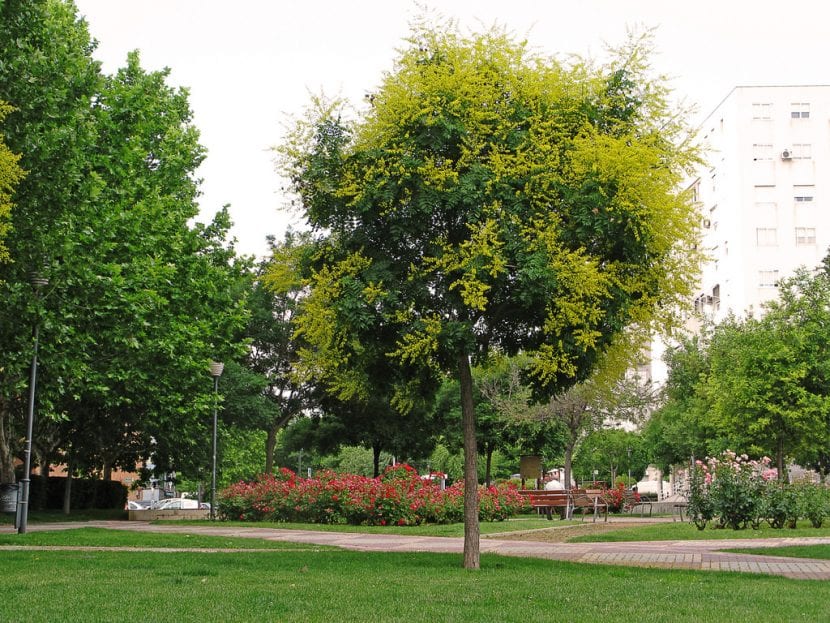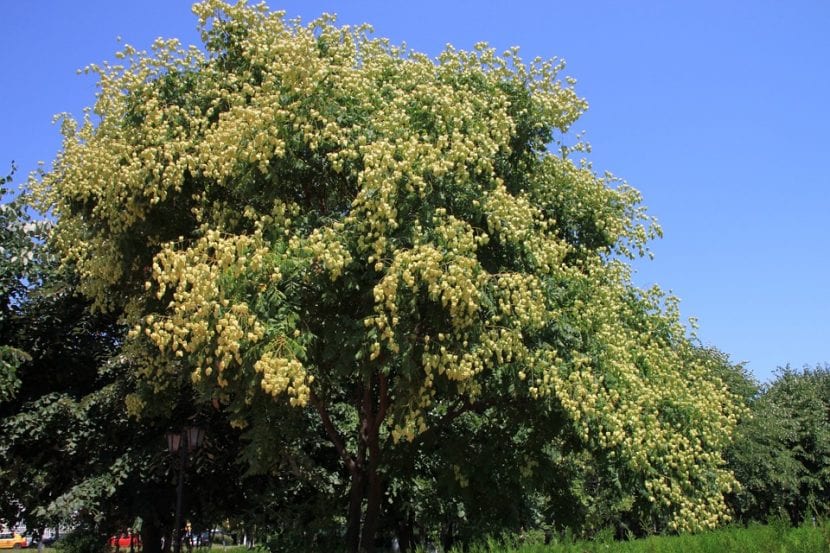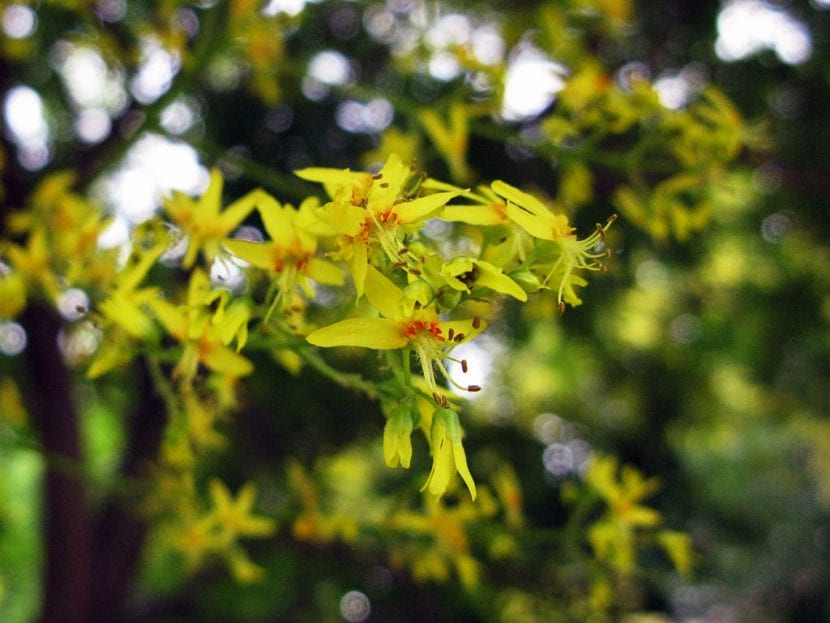
Image - Flickr / jacilluch
La Koelreuteria paniculata it is a tree of exceptional beauty. It is one of those that you can have as an isolated specimen because you know that both its flowers in spring and its reddish leaves in autumn will stand out from the rest of the plants. And, in addition, over time it gives very good shade, something that is undoubtedly appreciated, especially if you live in a warm-temperate zone.
But of course, To be able to enjoy it to the maximum it is important to know in which areas it adapts and in which it does not, as well as its care. Only then can we feel really proud of having acquired one. So let's go there 🙂.
Origin and characteristics

Known as Chinese soap, Chinese soap, Chinese lanterns, Chinese sapindo or lantern tree, it is a deciduous tree native to East Asia, specifically China and Korea. Grows to a height of 10-12 meters, with a wide crown of 5-6 meters in diameter.
The leaves are pinnate, 15 to 40cm long (sometimes 50cm), composed of 7-15 leaflets (pinnae) 3 to 8cm long, green in color except in autumn when they turn reddish. The flowers, which sprout in spring, are grouped in terminal panicles 20 to 40 cm long, have 4 petals and are yellow. The fruit is a capsule 3-6cm long by 2-4cm wide that contains seeds of 5-8mm in diameter, brown or blackish.
Cultivars
There are several, but two in particular are very interesting:
- Fastigiata: which has a narrow crown, which is perfect for small gardens or those where there is not much space.
- gold september: blooms in late summer.
What are their cares?

Image - Flickr / jacilluch
If you want to have a copy of lanterns, then I will explain how you should take care of it:
Location
It is a tree that must be abroad, in full sun, and protected from strong wind. Due to its characteristics, it is important that it be planted at a minimum distance of 5-6 meters from pipes, paved floors, etc., as well as from other large plants.
Earth
- Flower pot: fill with universal growing medium (for sale here).
- Garden: grows well in fertile, well-drained soils.
Irrigation
La Koelreutia paniculata is a plant that He is afraid of waterlogging and that he is not very happy with the drought, although this tolerates it better than stagnant water. To avoid problems, it is advisable to water only when necessary; that is, every time the land is almost dry.
To check its degree of humidity, you can insert a thin wooden stick to the bottom: if when you remove it it comes out practically clean, you can water. Another option is to use a digital moisture meter, but to be really useful you have to introduce it further from the plant, closer, since this way you will be able to get an idea of how the earth really is.
Subscriber

Guano powder.
In spring and summer it is advisable to pay it, since if we only gave him water, there would come a time when his health would weaken. But beware: there are many types of fertilizers that can be classified into two large groups: compounds (called chemical) and organic.
Any of them, well used, is good for the tree, but they have important differences:
- Compound fertilizers:
- They are very fast effective.
- They usually do not contain more than 2 or 3 essential nutrients (nitrogen, phosphorus and potassium), forgetting the others that are also necessary.
- Intensive use harms the environment.
- There is a real risk of overdose, so the instructions specified on the package must be followed to the letter.
- Organic fertilizers:
- In general, they are slow to work.
- They fertilize the soil and help improve the health of the plant.
- The roots are absorbing what they need, neither more nor less.
- They can contain pathogens if they are fresh.
- There is not much risk of overdose (with exceptions: guano, poultry manure).
Which is the best? Well I'm an advocate for guano (get it in powder here and liquid, for pots, here). It has many nutrients, it is organic and also its effectiveness is fast (you have more information here). But if you prefer, you can alternate compounds / organic, using one month one and the next another.
Pruning
Does not support pruningBut he does need a young tutor to get a straight trunk.
Pests
It is very resistant, but can be affected by:
- White fly: they are very tiny white winged insects that bite the leaves to feed on their sap. It is fought with sticky yellow traps (for sale here). More information.
- Big-headed worm: digs gallery in branches and trunks. It is removed by inserting a wire and removing it, and capturing adults.
Multiplication

It multiplies by seeds and by cuttings of soft wood. Let's see how to proceed in each case:
Seeds
Planting it is divided into two phases to facilitate germination, as they have a hard shell:
First phase - Cold stratification in the fridge in winter for three months
- First, a tupperware is filled with vermiculite previously moistened with water.
- Then, sprinkle with copper or sulfur to prevent the appearance of fungus.
- Afterwards, the seeds are sown, ensuring that they are a little separated from each other.
- Finally, they are covered with a layer of vermiculite, the tupperware is covered and placed in the refrigerator (where we put the dairy products, sausages, etc.).
Once a week you have to open the tupperware so that the air can be renewed.
Second phase - Sowing in seedbed
- Once spring arrives, you have to fill a seedbed (pot, milk or yogurt containers, ... or anything that is waterproof and has holes for drainage) with universal growing medium.
- Then, sow the seeds, putting rather a few in each one. For example, if you use a pot of about 10,5cm, do not put more than 2 because otherwise the seedlings would have problems growing well.
- Then sprinkle with copper or sulfur.
- Finally, cover them with a thin layer of substrate, and water again, this time with a sprayer.
So will germinate throughout the spring, placing the seedbed outside, in full sun.
Cuttings
The lantern tree multiplies by cuttings in late winter simply cutting a piece of soft wood about 40cm long, impregnating the base with homemade rooting agents or rooting hormones, and then planting it in a pot with vermiculite under glass.
This way, it will emit roots in 1 month or so.
Rusticity
It resists frosts of up to -12ºC, and lives well in somewhat warmer climates such as the Mediterranean. On the other hand, in areas without frost - not even weak - it does not adapt, since it needs to be cold and rest in winter to resume its growth in spring.

View of the tree in autumn.
What did you think of Koelreutia paniculata?